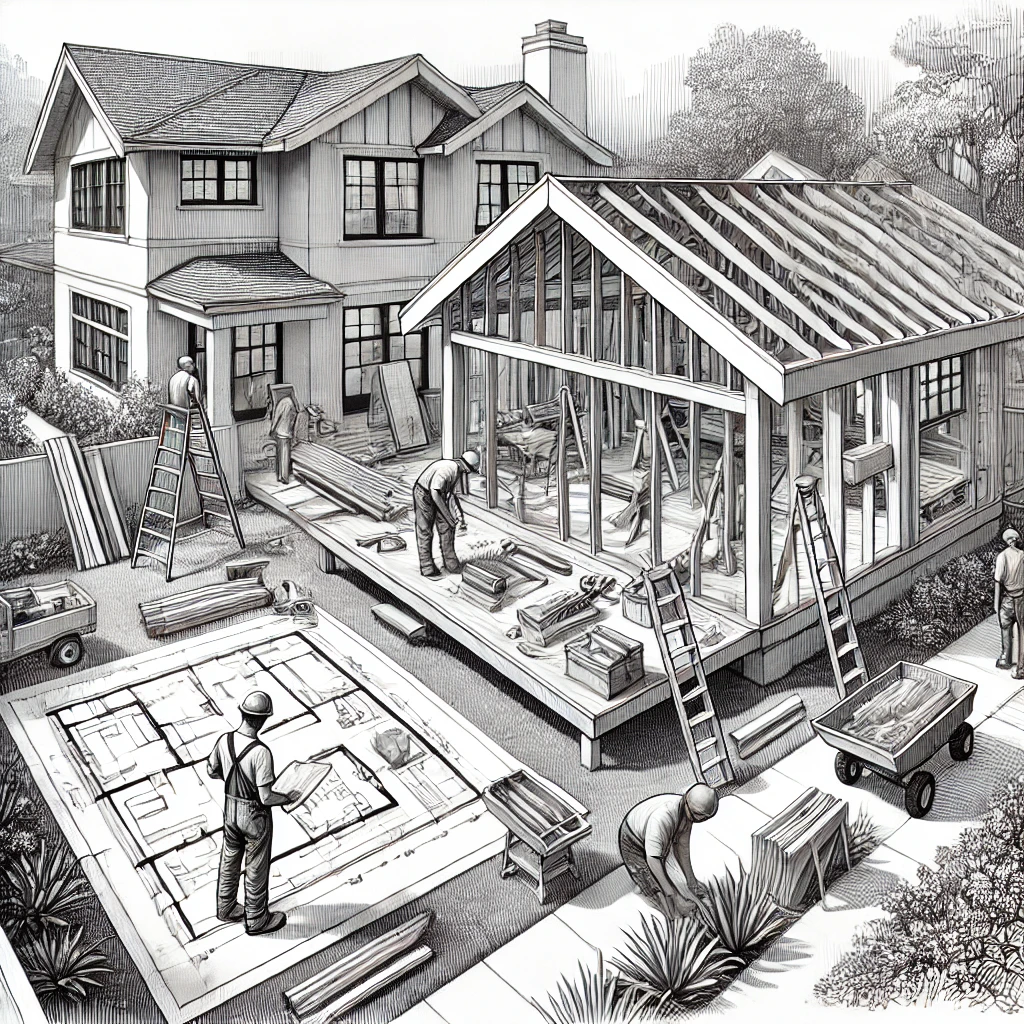Building an Accessory Dwelling Unit (ADU) can be a cost-effective way to add living space and increase property value.
While ADUs typically require significant investment, strategic planning and resource management can help minimize costs.
This article outlines practical steps to build an ADU on a budget without compromising quality.
10 Tips For Building An ADU On A Budget
Here are 10 tips you can use to save money while building an ADU.
1. Establish a Realistic Budget
Before starting the project, establish a clear and realistic budget.
- Cost Estimation: Include all potential costs, such as permits, materials, labor, and contingencies.
- Prioritize Needs Over Wants: Focus on essential features and avoid unnecessary luxuries to keep costs low.
Most ADUs cost between $20,000 and $150,000, and keeping track of the budget is an effective way to reduce overall cost, as you’ll be more likely to manage the funds effectively.
2. Choose a Simple Design
Opting for a simple, efficient design can significantly reduce construction costs.
JADUs, for example, cost much less than most generic ADUs simply due to the size difference.
- Pre-Approved Plans: Utilize pre-approved ADU plans available from local municipalities to save on design and approval time. The City of Portland is a great example of this, offering pre-approved layouts that can save a lot of time and money.
- Compact Layout: A smaller footprint reduces material and labor costs.
If you’re looking for a custom layout, you can use software like Presite to experiment with different floor plans.
3. Understand Local Regulations
Local zoning regulations and building codes might seem like a bunch of boring jargon that you can avoid, but it pays dividends to understand the landscape in your city to save yourself both time and money.
To do this, get in touch with your local building department and ask about their ADU regulations. You should be able to find lots of information online as well.
Some places even offer streamlined approval processes, including things like pre-approved ADU plans which can be approved and built much more quickly.
Remember, avoiding delays in construction = time and money saved.
4. DIY Permit Applications
Handling permit applications yourself can save money.
While it requires time and effort, it eliminates the need for professional services.
- Research Requirements: Thoroughly research permit requirements and processes.
- Prepare Documentation: Ensure all necessary documents are complete and accurate to avoid re-submissions.
If you’re not confident with this part of the process, it can often make sense to hire a professional – just make sure they have experience with ADUs specifically.
5. Use Cost-Effective Materials
Selecting affordable, durable materials can lower construction expenses without sacrificing quality.
- Recycled Materials: Using recycled or reclaimed materials can reduce costs and environmental impact.
- Standard Sizes: Purchasing materials in standard sizes minimizes waste and cuts costs.
Material costs have been rising for a while now due to various factors, so saving on this raw cost can have a huge impact on the overall cost.
6. Hire Local Contractors
Local contractors often offer competitive rates and are familiar with regional building codes and conditions.
- Get Multiple Quotes: Obtain quotes from several contractors to find the best price.
- Check References: Ensure contractors have good reputations and track records to avoid potential issues.
It’s important to choose someone who you trust and who has a great track record of positive reviews, as well as experience in the ADU construction space.
7. DIY Where Possible
Undertaking parts of the construction yourself can save labor costs.
Tasks like painting, landscaping, and interior finishing are often manageable for DIY enthusiasts.
- Skill Assessment: Only attempt tasks you are confident in to avoid costly mistakes.
- Safety First: Ensure all DIY work complies with safety standards and regulations.
If you don’t have direct experience with electrical or plumbing work, leave that to the professionals.
8. Explore Financing Options
Several financing options can help manage the costs of building an ADU.
- Home Equity Loans: Using home equity to finance construction can offer lower interest rates than personal loans.
- Government Grants and Incentives: Some local governments provide financial assistance for ADU construction.
- Private Lenders: Various private lenders offer loans specifically for ADU projects, often with flexible terms and competitive rates.
Opting for financing can not only help manage costs, but it can actually reduce the overall expenditure if you can secure finance at a lower rate or use it as a short-term solution while waiting for the funds to arrive from another location/venture.
It’s even better if you can get some help from the government toward the construction costs.
9. Efficiency (Long Term Energy Saving)
Incorporating energy-efficient features can reduce long-term operating costs.
- Insulation and Windows: Proper insulation and high-quality windows reduce heating and cooling costs.
- Energy-Efficient Appliances: Investing in energy-efficient appliances lowers electricity usage and expenses.
- Solar Energy: Solar is a requirement in many places, and can help you save a lot of money in the long run on energy costs.
While these don’t technically help with the upfront cost, you can save thousands of dollars on energy bills over the long term by opting for more efficient materials and construction.
10. Minimalist Design
A minimalist approach to furnishing and decorating the ADU can keep costs down while creating a functional and stylish space.
- Multi-Functional Furniture: Choose furniture that serves multiple purposes to save space and money.
- Simple Decor: Focus on essential decor items to avoid clutter and unnecessary expenses.
Minimalism not only offers a lower cost, but it’s also super trendy as well.
